Australia’s National Local Government Newspaper
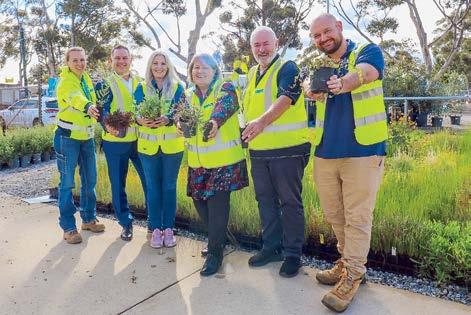


TheCityofGosnellsissettocultivate amoresustainableandgreener future,withthedevelopmentofanew productionnursery.
Once operational, the nursery will produce 9,500 trees and more than 100,000 seedlings each year, specifically selected for the City’s streets, parks and nature reserves.
Mayor Terresa Lynes said the City has allocated $400,000 toward the project in its 2025/26 Budget.
“Earlier this year, we set an ambitious goal to achieve 30 per cent urban canopy coverage on City-managed land by 2040. This nursery will play a key role in reaching that target,” she said.
“The City of Gosnells already plants thousands of trees and tube stock annually to cool our suburbs, improve biodiversity and create more pleasant environments for residents and visitors.”
Currently, the City purchases plants from private suppliers, a process that has presented challenges with stock availability in recent years.
“The new nursery will allow the City to grow species suited to local conditions, reducing our dependence on the private market and avoiding competition for stock,” Mayor Lynes said.
Australia’scouncilsareexpectedtospendmorethan$2billionoverthenextfiveyearstofuture-prooftheircommunities fromthechangingclimate,accordingtonewAustralian-firstresearchreleasedinlateJune.
ALGA’s Adapting Together: Local Government Leadership in a Changing Climate report showed the climate-resilient investments by councils are estimated to provide up to $4.7 billion in avoided costs and benefits to communities by 2030.
Speaking at the National General Assembly (NGA) in Canberra, ALGA President Mayor Matt Burnett said: “The changing climate is putting pressure on communities, and this groundbreaking research shows councils are leading the way in preparing for and managing these ever-increasing impacts, including from natural disasters.
“These examples include planting trees to combat heat, providing community education and preparation for bushfires, coastal hazard management systems and upgrading stormwater systems and flood resilience programs,” Mayor Burnett said.
“The climate of every community is different, and it’s impressive to see innovative examples and strong leadership by councils across Australia to reduce climate risks and future-proof their communities.”
The new report used more than 200 examples of councils taking action to address climate impacts, and five case studies to model the national value of local government climate adaptation.
“Climate-resilient infrastructure is expensive and takes time to build, so we need sustainable funding from the Federal Government to implement long-term planning and adaptation now and into the future,” Mayor Burnett said.
“We are asking the Government for a new
$400 million climate adaptation fund, distributed to all Australia’s councils each year, to deliver ongoing and sustainable place-based climate solutions.”
Lord Mayor of Hobart Anna Reynolds said: “The Federal Government rightly recognises the best climate solutions come from those closest to the risks but there’s a huge gap between recognising this principle and providing the funding needed to deliver it to local communities.
“In Hobart, we’ve seen how collaboration through the ‘Sparking Conversations, Igniting Action’ program helped households prepare for bushfires, manage vegetation, and strengthen community connections.”
Lockyer Valley Regional Council Mayor Tanya Milligan said: “We have built a strong reputation for ensuring we adapt to climate challenges through a range of measures such as flood modelling, limited development zones, buy-backs and flood mitigation.
“Adapting to climate challenges is critical for local governments, and it’s vital other levels of government consider and invest in the recommendations of this new report, to ensure communities at risk have a safer and more hopefilled future.”
Background and key findings
· Cost-benefit analysis outlined in the report estimated council projects produced benefits of at least $0.8 and $3.1 per $1 of cost.
· Therefore, a conservative estimate of local governments’ expenditure on climate adaptation is $400 million per annum, or $2 billion to 2030. This $2 billion investment is estimated to benefit local communities by between $2.2
and $4.7 billion.
· ALGA’s climate adaptation report was produced in partnership with Nation Partners and Ricardo.
Council case studies
The following council case studies are featured in the Adapting Together: Local Government Leadership in a Changing Climate report:
City of Darwin (NT) – Urban cooling
The 2030 Greening Darwin Strategy aims to increase tree canopy coverage in areas vulnerable to heat and cyclones. It includes planting cyclone-resistant, climate-suitable trees along transport routes, near recreational facilities, and in suburbs with low canopy cover.
Lockyer Valley Regional Council (QLD) –Flood management
Following the 2022 floods, the Australian and Queensland Governments launched a joint initiative to aid Queensland residents in recovery and flood resilience. The Voluntary Home BuyBack (VHBB) program was part of this effort.
Lockyer Valley participated by purchasing 24 properties in a high flood risk area.
City of Hobart (TAS) – Bushfire resilience
The City of Hobart was involved in the ‘Sparking Conversations, Igniting Action – Greater Hobart Resilience Program’ to improve bushfire preparedness through education, household planning, and vegetation management. The program boosted the capacity to respond to and recover from bushfires.
Moyne Shire Council (VIC) – Coastal hazard management
Moyne Shire Council amended planning in Port Fairy, in southern Victoria, to prevent new de-
velopment in areas at risk from sea level rise, through a coastal hazard management plan. This policy addressed long-term climate risks in the area, which is prone to flooding and coastal erosion, storm surges, and rising sea levels due. City of Onkaparinga (SA) – Climate risk assessment and response plan
The City of Onkaparinga undertook a climate change risk assessment to identify climate-related gaps in the council’s strategic and governance structures. In addition, the assessment identified physical and transition risks impacting service delivery, asset management and operations. The risk assessment culminated in the development of the Climate Change Response Plan 2022-2027.
of Cockburn (WA) – CY O’Connor Artificial Reef
The City of Cockburn, in partnership with global marine and subsea services company MMA Offshore, doubled the CY O’Connor Artificial Reef’s 135 bombora modules to 270 in November 2024. Preliminary findings by The University of Western Australia (UWA) and Oceans Institute showed the reef has contributed to a 10 per cent reduction in wave height and reduced wave energy by 20 per cent.
Cobar Shire Council (NSW) – Planning a climate resilient airport
Cobar Shire Council integrated climate change considerations into a 20-year development strategy for Cobar Regional Airport. The plan outlined climate-responsive strategies to ensure the resilience of airport operations and infrastructure. It also included a revised airport layout to minimise environmental risks.
Future proofing essential
Interested to see ALGA’s Adapting Together report. The estimate that Australian council’s are expected to spend more than $2billion over the next five years to future proof their communities from the climate change may seem like a large figure – but when you look at the communities currently rebuilding from large weather events it is certainly necessary. Months and even years on from recent catastrophic events, regions including Lismore, Tweed and Townsville (highlighted on p10) are still re-instating infrastructure and facilities and their residents rebuilding lives.
ALGA are to be applauded for using the recent NGA to highlight the pressure that all councils face in the future in the face of the climate changing.
- Tania Phillips Editorial Coordinator LG Focus
The Lockhart Shire Council was pleased to welcome the Hon Ron Hoenig MP, NSW MinisterforLocalGovernment,andhisChiefofStaff,PeterMcCabe,totheregionon Wednesday,2July2025.
The Minister’s visit followed his attendance at the REROC Board Roundtable in Wagga Wagga earlier in the day, providing a valuable opportunity for engagement with local leaders and the wider community.
Minister Hoenig began his visit with a meeting at Lockhart Shire Council offices with Dr Joe McGirr - Member for Wagga Wagga, Mayor Peter Sharp, and General Manager Gavin Rhodes. The discussion focused on a range of key topics, including:
· Road Funding
· Enabling infrastructure
· Critical need for housing for essential workers, including health professionals.
· Advocacy for quarantined (non-competitive) grants for rural councils
· Support for the full adoption of the RFS PAC Report recommendations
· Funding progress for key Council projects, including masterplans for Brookong Creek and the Lockhart CBD upgrade.
Following the meeting, Minister Hoenig attended an afternoon tea with councillors and senior Council staff at Green’s Gunyah Museum.
This informal gathering offered further opportunity for community interaction and included a tour of the Tim Fischer Gallery and the Doris Golder Wool Art Gallery.
Australia’s National Local Government Newspaper
Website: LGFocus.com.au
Noosa Office:
Telephone: (07) 5455 6946
Address: 36 Mary Street, Noosaville Qld 4566
Pakenham Office: Telephone: (03) 5945 0666
Address: 10 Army Road, Pakenham VIC 3810
Network with LG Focus twitter.com/@LGFocusau facebook.com/LocalGovernmentFocus
Editorial:
E: editorial@LGFocus.com.au
Advertising:
E: advertising@LGFocus.com.au
Classifieds:
P: 1300 666 808
E: sales@NetworkClassifieds.com.au
EDITORIAL
Tania Phillips Journalist
E: tania.phillips@StarNewsGroup.com.au
ADVERTISING
Michelle Gibson Sales Executive
E: michelle.gibson@StarNewsGroup.com.au
P: 07 5292 5304
M: 0413 608 678
Brett Greene Sales Executive
E: brett.greene@NoosaToday.com.au
P: 07 5292 5302
M:
A visit was also made to That Butcher Shop, to congratulate them on their recent global awards. Lockhart Shire Mayor Peter Sharp expressed his appreciation for the visit.
“It was a privilege to welcome Minister Hoenig to our Shire and provide first-hand insights into the opportunities and challenges our rural communities face,” Mayor Sharp said.
“This visit was a productive step forward in strengthening existing collaboration between local and state governments.”
The Lockhart Shire Council thanks all who participated in making the visit a success.
Hon.RonHoenigMP-NSWMinisterforLocal Government,MayorPeterSharpLockhart ShireCouncilandDrJoeMcGirrMemberfor WaggaWagga.
ALGA Climate adaptation webinar Via Teams 30 July
ALGA recently conducted new research to paint the national picture of local government climate risk management and adaptation work. This webinar on 30 July 2025 will: Give you information about how other local governments approach the risks and opportunities that climate change pose to their communities. Enable discussion with other local government attendees about their approaches, wins and challenges in managing climate change impacts.
Provide guidance on the tools, courses and learning opportunities available for local governments working on climate risk. ALGA welcomes you to a free, online discussion about the diverse and significant contributions that local governments are making to adaptation in Australia. The webinar will be broken into two sections, which you can join as relevant to you: 2-3 pm Session One: ALGA’s Adapting Together research report and open discussion on managing the impacts of a changing climate. 3-4 pm Session Two: Discussion on resources available to local governments to understand and manage climate risks by ALGA and the Australian Department of Climate Change, Energy, Environment and Water (DCCEEW).
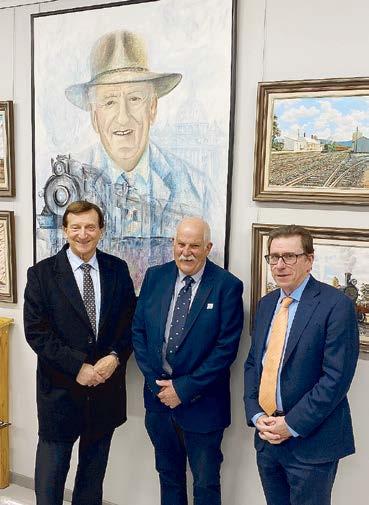
Bendigo
11-12 November
Registrations for the 2025 National Local Roads, Transport and Infrastructure Congress from 11-12 November in Bendigo are now open.
The National Local Roads, Transport & Infrastructure Congress is an annual local government event featuring experts and guest speakers covering a comprehensive program focused on roads, transport, mobility, road safety and community infrastructure.
Held in a regional area of Australia, the twoday national Congress involves government leaders, academics, industry bodies and council officials.
This Congress also provides a valuable opportunity to expand professional networks and connectwithlocalgovernmentleaders,decisionmakers and suppliers who can support council initiatives and innovations.
IPWEA International Public Works Conference
Sydney 25-28 August
IPWEA invites the submission of abstracts to be considered for presentation at the next International Public Works Conference (IPWC), the largest public works Conference held in Australia. Running at the International Convention Centre Sydney from August 25 to 28, 2025.
Contributed abstract presentations are an integral part of the IPWC program. Offering dele-
gates the chance to hear from local practitioners oninnovative,creative,andrelevantprojects,that will expand their thinking on a variety of issues within the conference theme: ‘Shaping Tomorrow’s World’.
Australian Mayors Summit Against Antisemitism
Australian Mayors Summit Against Antisemitism
Gold Coast
3-5 September
The 2025 Australian Mayors Summit Against Antisemitism, hosted by the Combat Antisemitism Movement (CAM) and chaired by the Gold Coast Mayor Tom Tate, will bring together more than 200 local government leaders, and community advocates from across Australia in a collective effort to secure and nurture common understanding and safety in our communities. Local Government is uniquely positioned on the front line of communities to proactively confront hate, where it is most acutely felt, and local leadership on this issue sets a powerful example that can be emulated both at home and globally.
As antisemitism rises globally, an international community is responding — from the United States to Germany, Greece, and Latin America. Now, it’s Australia’s turn to join this growing movement of local leadership. You’ll be joined by fellow local government leaders, Members of Parliament, community and religious leaders from all denominations, including the 2024 conference host from the United States, Beverly Hills Mayor Sharona Nazarian.
Hundredsofnewapprenticesandtraineesvitaltothedeliveryofessentiallocalserviceshavehitthegroundrunning withcouncilsacrossthestate,thankstoanew$252.2millionNSWGovernmentFreshStarProgram.
The new program funds the wages of an additional 1,300 apprentices, trainees and cadets in the local government sector over the next six years.
Councils have now been given the green light to employ 1,008 new apprentices, trainees and cadets this year under the first two rounds of funding.
NSW Local Government Minister Ron Hoenig said hundreds of new workers began their new roles with councils across the state earlier this year, with more onboarding every month as councils fill roles to coincide with the start dates of a wide range of training programs.
“From Wollongong to Walgett, the Blue Mountains to Ballina, the Fresh Start program is an investment in the future of local government in NSW,” Hoenig said.
“The uptake from councils has been fantastic and goes to show how desperately councils need this support, especially in regional and rural areas.

and childcare.
“Vocational education and training provides a valuable career path for many young people and there’s no doubt the Fresh Start program will help build a stronger workforce for NSW councils.”
More than 60 per cent of the approved new roles are in regional and rural councils, providing a major boost to regional communities and more job opportunities for people in country towns.
The Fresh Start program enables students and school leavers to study and learn on the job while gaining a nationally accredited qualification.
help tackle the housing crisis.
A 2022 report by the Australian Local Government Association found that 91 per cent of respondent councils in NSW reported skills shortages, with close to 30 per cent reporting shortages in trades such as plumbing, automotive and mechanical work.
The sector also has an ageing workforce which is threatening the loss of essential skills and knowledge as workers retire.
Minister for Skills, TAFE and Tertiary Education Steve Whan said:
“It’s pleasing to see the Fresh Start program helping to plug gaps across the local government sector in NSW, including in critical skills shortages areas such as construction
“We’re opening the door for hundreds of young people to learn life-long skills, making sure councils have the workforce they need to continue delivering for their communities.”
Councils have applied for the jobs they need most including 58 more apprentice mechanics, 25 electricians, 146 parks and gardens staff, 82 civil construction apprentices and trainees and 44 early childhood trainees.
Forty-seven planning cadets and trainees and 58 in engineering have also been approved, vital to driving local housing approvals and enabling supporting community infrastructure to
The Fresh Start program supports the government’s goal of boosting the number of apprentices and trainees in councils to make up 15 per cent of the local government workforce, to address the growing skills shortage that is slowing down the delivery of homes and community infrastructure.
The program has shown great success with nearly 90 per cent of local government organisations successfully applying for funding.
A third round will be open to councils soon aimed exclusively at apprentices, providing opportunities for hundreds more young people start jobs in councils from January next year.
CouncilsacrossNSWarenowabsorbingastaggering$1.5billionincostshiftingfromStateandFederalgovernments each year – a cumulative $11.3 billion over the past decade – according to a new report commissioned by Local GovernmentNSW(LGNSW).
Cost Shifting 2025: How State Costs Eat Council Rates was prepared by independent consultants Morrison Low. It reveals the $1.5 billion burden on councils is an increase of approximately $140 million (10 per cent) since the last report for the 2021/22 financial year, when the total cost shift was estimated at $1.36 billion.
Cost shifting occurs when State and Federal governments force councils to assume responsibility for infrastructure, services and regulatory functions without providing sufficient supporting funding.
LGNSW President Mayor Phyllis Miller OAM said councils faced unprecedented financial strain and warned the practice of cost shifting – overwhelmingly from the NSW Government - must end.
“Councils are at breaking point. The combination of relentless cost shifting, rate capping and inadequate State and Federal funding is eroding the sector’s financial sustainability,” Mayor Miller said.
“Councils are having to foot the bill for State and Federal functions and services that they didn’t design and aren’t funded to deliver,” she said.
“This includes the collection of the NSW Government’s Waste Levy and payment of the Emergency Services Levy, and the huge shortfall in funding for our beloved libraries. There’s also the significant loss of income when councils aren’t allowed to charge rates on certain properties even though they are big users of council services,” Mayor Miller said.
“This means on average, nearly $500 per rate-
payer in NSW is being diverted from essential local priorities like roads, libraries, sporting facilities and community programs. These are services our communitiesneed,wantanddeserve,andthey’rebeing severely compromised by councils needing to pick up the bill on behalf of the State,” she said.
Multiple inquiries into the financial sustainability of councils at both State and Federal levels over the past 18 months confirmed the severity of the situation. The November 2024 report of the NSW Parliamentary inquiry into the ability of councils to fund infrastructure and services called for the NSW Government to identify opportunities to reduce cost shifting to local government.
Top cost shifts include:
· Forced rate exemptions: Where councils are re-
quired to exempt profit-driven State-owned corporations and other organisations from paying rates, even though they use and benefit from local government services and infrastructure.
· The Waste Levy: An invisible State Government tax collected through waste management fees.
· Development assessment and regulatory functions: Including where the NSW Government sets fees well below the actual cost of these functions.
· Emergency services obligations: Including the requirement that councils fund 11.7 per cent of the NSW Government’s Emergency Services Levy cost.
The Australian Mining Cities Alliance (AMCA) has welcomed the strong national support demonstrated by local governments across Australia at the recent Australian Local Government Association (ALGA) National General Assembly,heldinCanberrafrom24–27June.
SpeakingonbehalfofAMCA,GlennWilson,Chair of AMCA and Mayor of the City of KalgoorlieBoulder, expressed the Alliance’s satisfaction with the adoption of motions that align directly with AMCA’s key policy positions.
“The endorsement of these motions by councils nationwide sends a clear message to the Federal Government that mining communities are vital to Australia’s economy and deserve equitable support,” Mayor Wilson said.
“Whether it’s ensuring our funding models reflect the true full-time equivalent (FTE) populations of our regions, addressing the housing affordability crisis, or securing fair returns for the immense economic contributions of resourceintensive regions, these motions strongly support the work AMCA has been leading for years.”
AMCA also acknowledged the leadership of two of its member councils—Isaac Regional Council and the City of Kalgoorlie-Boulder—in puttingforwardkeymotionsthatsecurednational backing. Isaac Regional Council championed a motion calling on the Australian Government to formally recognise FTE populations in federal funding models, acknowledging the additional demand placed on infrastructure and services by non-resident workforces in mining regions.
This motion addresses a long-standing concern for communities with significant FIFO/DIDO
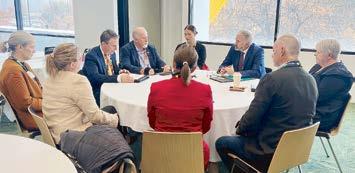
populations, ensuring funding reflects the real needs of these regions.
The City of Karratha led the way with a motion advocating for increased housing affordability and long-term residency in mining-affected communities, through reforms to Fringe Benefits Tax (FBT). Their proposal called for a 100% FBT exemption for housing-related benefits in designated mining areas, a key policy that AMCA
has long championed.
Key motions supported at the Assembly included:
· A call for a revenue-sharing model that fairly returns a proportion of Commonwealth taxation revenue to local governments in high-contributing mining regions, to fund essential community and social infrastructure.
· Support for FBT reform to encourage long-term residency and home ownership in miningaffected communities, through a 100% FBT exemption for housing-related benefits.
· Advocacy for formal recognition of FTE nonresident populations in federal funding models, to ensure communities receive appropriate resources to meet the demands placed on their infrastructure and services.
These motions align with the positions outlined in AMCA’s key policy documents, including its position papers on sustainable regional mining communities, tax reform, the impacts of FIFO/ DIDO on the workforce, and national data collection for mining workforce and population trends.
“Mining regions like Kalgoorlie-Boulder, Isaac, Karratha, East Pilbara, Broken Hill, and Mt Isa generate billions for the nation yet face real challenges, from infrastructure strain to workforce instability,” Mayor Wilson said.
“The national support we’ve seen this week is a step in the right direction towards more sustainable, liveable, and economically resilient regional communities.”
AMCA will continue to work closely with federal, state, and local governments to ensure these policy reforms are implemented, delivering tangible benefits to mining communities and, ultimately, strengthening Australia’s economic future.
TheMurrayRiverGroupofCouncils(MRGC)hascontinueditsstrongadvocacyonbehalf ofnorthernVictoriancommunitiestakingitsmessagetoCanberra,withsevenmotionsto theNationalGeneralAssemblyoftheAustralianLocalGovernmentAssociation(ALGA) supportedbydelegates.
MRGC Chair, Cr Dan Straub, said the result reflected the strength of regional collaboration and the common sense approach to the solutions MRGC put forward to the challenges facing northern Victorian communities.
“This is a great endorsement of our advocacy as a united group of councils,” Cr Straub said.
“We spoke with one voice on some of the big issues facing our communities and I am pleased to say our message was heard loud and clear.”
The Group also advocated directly to the Federal Minister for Local Government, Regional Development and Emergency Management the Hon. Kristy McBain MP.
“We were grateful Minister McBain met with us and she clearly listened and heard these key challenges facing our Councils,” said Cr Straub.
The motions, developed by MRGC member Councils and presented by Loddon Shire on their behalf, tackled critical issues including housing shortages, road and infrastructure repair and resilience, local government financial sustainability, energy transition impacts, swimming pool upgrades, and water reform in the Murray-Darling Basin.
Cr Straub said the success of all seven motions showed the clear alignment between MRGCs regional priorities and national concerns.
“Every motion we put forward was grounded
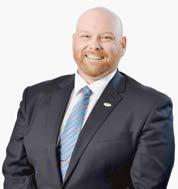
Cr Dan Straub, Mayor of Loddon Shire, Chair Murray River Group of Councils.
in the lived experiences of our towns and rural industries,” he said.
“We made the case for common-sense, local solutions that can deliver safer regional roads, more homes in our towns, safeguard our irrigation districts and ensure our communities benefit from the energy transition that is happening right here in our region” said Cr Straub.
The adopted motions call for:
· A Regional Infrastructure Resilience Fund to upgrade assets before disasters strike;
· A multi-year fund to unlock regional housing development by investing in trunk infrastructure such as water, drainage, sewers, power and roads;
· A national funding commitment to help repair and maintain the crumbling local road network; • Renewal of our regional pools to maintain water safety and strong communities; and
· An end to damaging open-market water buybacks, calling instead for local leadership in future Basin Plan reform.
“Our communities are shouldering more responsibility with fewer resources,” Cr Straub said. “The Assembly gave us the platform to say that has to change and we’re proud that the broader local government sector stood with us.”
The MRGC’s delegation included councillors and officers from all six member councils: Mildura, Swan Hill, Gannawarra, Campaspe, Loddon and Moira
. “We’re grateful to ALGA for what was a thought provoking and worthwhile conference and we’ll continue to work with all levels of government to turn these motions into real outcomes for our region,” Cr Straub said.
The peak body for local government in NSW has acknowledged some positive announcementsintheStateBudgetdeliveredbyTreasurerDanielMookhey.
LGNSW president Mayor Phyllis Miller OAM welcomed some measures that councils would support for their communities but said she was disappointed to see only a few benefits for the local government sector included in the Budget Papers.
“The financial sustainability of the local government sector in NSW continues to remain a significant challenge and it was disappointing that the Budget failed to address this,” said Mayor Miller.
“We look forward to the State Government working with us to encourage the Federal Government to return our Financial Assistance Grants back to one per cent,” she said.
“Councils across the state face ongoing cost pressures, particularly from disaster recovery and resilience-building efforts, but also due to cost shifting from the NSW Government – compounded by insufficient grants from both state and federal governments”. However, Mayor Miller said the 2025-26 budget did include some significant positive announcements for the local government sector, including:
· $4.2 billion in disaster relief across the forward estimates, with the government an-
ticipating that this figure would increase in response to previous and potentially new natural disasters.
· Welcome boosts for biosecurity measures, including to protect against pest animals and weeds. This includes an additional $100 million to develop an improved detection, protection and response model.
· A range of budgetary measures to promote housing development, which reflect recognition that emphasis on the planning system alone will not resolve the housing crisis.
· A commitment of $6 million over two years to support Central Darling Shire Council’s transition back to elected representation and assist the council in achieving longterm financial stability.
· $472.9 million for improving the Biodiversity Offset Scheme and associated measures.
· Increased investment in rural and regional health (including dental) and mental health services.
While Mayor Miller welcomed these positive announcements, she also pointed to some disappointing funding gaps.
“An increase of seven per cent in Emergency Services Levy (ESL) council contributions
from last year will be devastating. While the cost of the increase to councils will be largely recovered through an increase in the rate peg for each council, it is still a cost to our community members that will have to be collected by councils,” Mayor Miller said.
“In addition, the government is yet to make a funding commitment to renew or replace the Safe and Secure Water Program (SSWP). This is a project that LGNSW has been advocating for a commitment of $1 billion over four years,” she said.
“Also, despite the Treasurer’s speech focussing on the need for housing across the state and setting out a guarantee for the development industry, there is no new guarantee for our communities as there is no new funding for public and social housing, and a conspicuous lack of investment in infrastructure betterment and resilience, that would help our communities better withstand future disasters,” Mayor Miller said.
“LGNSW will continue to advocate strongly for the sector to hold the State and Federal governments to account and ensure our councils and communities are strengthened and enhanced well into the future,” Mayor Miller said.
TheMunicipalAssociationofVictoria(MAV)haslaunchedit’sinauguralMAVlabInnovation Awards – a bold new program designed to recognise and celebrate the people and projectsreshapingthefutureoflocalgovernmentacrossVictoria.
From reimagining service delivery to transforming public spaces, council teams across Victoria are tackling complex challenges like climate change, economicresilienceandcommunitywellbeingwith creativity, care and commitment.
The MAVlab Innovation Awards will spotlight this work – from quiet reinventions to big, bold transformations. “Innovation in local government takes courage, vision and persistence,” MAV CEO Kelly Grigsby said.
“From rapidly evolving technology to social
changes, shifting economies to environmental pressures,ourlocalcommunities–andthecouncils thatrepresentthem–areattheforefrontofmultiple transformations happening simultaneously.”
The program includes 16 awards across a variety of topics and disciplines to recognise people and projects demonstrating innovation in areas such as leadership, community wellbeing, storytelling, and financial ingenuity. Each award celebrates projects and people that are pushing boundaries, testing new ideas, and delivering measurable im-
WALGAisdeeply disappointedwiththe NationalManagement Group’sdecisionto abandoneradication plansforthe PolyphagousShot-hole Borer,astheresponse movestoamanagement phase.
The WA State Government has announced a National Transition to Management plan will now be developed. WALGA will advocate that Local Government, and other key stakeholders, must be actively engaged in the development of the longterm management arrangements.
The impact of PSHB on Perth’s already depleted tree canopy is significant, with 4,734 infested, mature trees removed to date. A long-term funding commitment from the State Government is required to ensure that our native forests and horticultural industries are protected.
WALGA President Karen Chappel AM JP said the decision to move from eradication to a management phase for PSHB was a result of the inadequacy of the State Government’s early response to PSHB.
“WALGA has long been concerned about the effectiveness of the State’s PSHB response and has been calling for greater transparency, research into control methods and more community education and engagement,” President Chappel said.
“This failure will have significant implications for Local Government, who are already spending millions to control PSHB and increase tree canopy, and will now face the additional, ongoing costs of managing or removing infected and dying trees in public parks and streets.
“While the WA Tree Recovery Program is a step in the right direction, there is much more to be done and in the transition to a management phase, more direct funding is needed to assist Local Governments.
“Without ongoing national support, managing PSHB will require a significant, long-term investment from the State Government to assist Local Governments.”
Two zones remain for Perth metro area to help slow the spread and reinforce strict quarantine rules.
An online resource with an interactive map for the community to see what Quarantine Zone they live in is available here: https://www.dpird.wa.gov.au/pshb.
pact. From strategic thinkers to frontline changemakers, we’re shining a light on the full spectrum of local government innovation.
Open to all Victorian council staff, from executives to council officers, the MAVlab Innovation Awards are an opportunity to share, celebrate, and scale innovation happening across the sector. Nominations close: 5.59pm, Thursday 31 July 2025 Registrations are open to attend an information session: mavevents.cventevents.com/mavlabinnovationawardsinfo
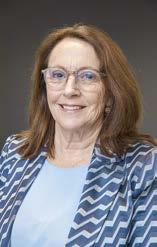
LGASouthAustraliahasannouncedthatChiefExecutiveOfficerClintonJurywillstep downfromtherole,followingnearlyfouryearsofleadership.
Since joining the LGA in October 2021, Mr Jury has helped shape the organisation’s strategic direction, strengthening its value to members and fostering a positive, high-performing workplace culture.
LGA President, Mayor Dr Heather HolmesRoss, acknowledged Clinton’s significant contribution to the organisation and the broader sector.
“Clinton is known and respected across local government as a trusted, values-driven leader who has guided the organisation through change and growth, delivering stability and strengthened government engagement,” Mayor Holmes-Ross said.
“On behalf of the Board, I’d like to thank him for his strategic guidance, integrity and genuine care and commitment to our member councils.
“Under Clinton’s leadership, LGA has successfully negotiated new state and federal funding for local government priorities, built effective partnerships across state agencies, and secured an ongoing seat at State Cabinet each quarter.
“He has also been instrumental in driving internal culture, contributing to organisational maturity.”
During his tenure, Mr Jury also led member support for the 2022 Council Elections and oversaw the association’s support for implementation of local government reforms, including the introduction of LGA’s Mandatory Train-

ing Standards.
Reflecting on the organisation’s next chapter, Mr Jury said the time was right for new leadership to take the reins.
“LGA is about to launch a new strategic plan, and the organisation is well-positioned to take this forward under new leadership, with a strong foundation in place to enhance the work we already do for members,” Mr Jury said.
“There is so much I am proud of in my time at LGA, especially the engagement with member councils, hearing firsthand what matters to them and seeing the difference they make in
Back by popular demand, the Government Lounge is once again your destination for vital conversations on waste recovery and sustainability in Victoria. Featuring Sustainability Victoria, Recycling Victoria, and EPA Victoria, this dedicated space brings together key government stakeholders to explore collaborative solutions, tackle recycling challenges, and drive real innovation in sustainability.
“We’re proud to provide a space where community, industry and government can come together to shape meaningful progress in this sector.”
Sherri Pearson, Waste Expo Australia Exhibition Manager
communities.
“Local government is a vital part of South Australia’s public sector and I’m proud of the impact LGA continues to have in strengthening the role of councils and supporting their capacity to serve their communities.
“I leave knowing the organisation is in a strong position, with a clear sense of purpose and a capable, committed team driving it forward.”
An Acting CEO will be appointed to lead the organisation while a recruitment process for a permanent appointment is underway.
Victorian councils are reporting a surge in homelessness across the state and are being forced to respond without the support or fundingtheyneed.
A landmark 2024 survey by the Municipal Association of Victoria (MAV) – Homelessness in Victoria – found 86 per cent of councils are seeing worsening homelessness in their communities. Yet, local government receives no dedicated funding from state or federal governments to respond to this growing crisis.
MAV President Cr Jennifer Anderson said the findings are a wake-up call.
“Councils are on the frontline in our parks, libraries, and maternal health centres, but we’re being asked to respond more and more to our communities needs without adequate funding and resources to do so,” Cr Anderson said. “We’re seeing more young people, families, and older women falling through the cracks. And while we’re not funded or mandated to provide homelessness services, many councils are stepping in because our communities need us to.”
Despite not being specialist providers, more than 90 per cent of metropolitan councils and half of rural and regional councils reported having some form of homelessness response effort in place. The MAV is calling for a new approach from state and federal governments that recognises the role of local government in preventing and responding to homelessness.
Why local government can’t afford to miss Waste Expo Australia.
As the frontline of waste management and sustainability, local government plays a critical role in shaping Australia’s transition to a circular economy. Waste Expo Australia, returning to Melbourne 29-30 October, offers councils an unparalleled opportunity to connect with the latest innovations, policy updates, and suppliers driving real-world impact across the sector.
With more than 130 exhibitors and a twoday conference featuring national and international experts, the expo is a chance to explore proven technologies and services that directly support local operations - from kerbside collection and organics processing to community education, resource recovery, and infrastructure planning. It’s also a unique chance to meet peers from across the country, sharing lessons learned and successful strategies.
A standout feature for councils is the Government Lounge, returning in 2025 after a successful debut, featuring Sustainability
Victoria, Recycling Victoria, and EPA Victoria. This dedicated space fosters direct dialogue with regulators and policy leaders, providing clarity on compliance, funding opportunities, and strategic planning priorities.
Free to attend, the expo is designed to be accessible for regional and metro councils alike. Whether you’re seeking solutions for landfill diversion, smarter procurement, or building greener infrastructure with recycled materials, Waste Expo Australia puts ideas into action.
For local government professionals, attendance isn’t just valuable - it’s essential. The expo brings together the people, policies, and technologies shaping the future of sustainable resource management. Councils looking to lead with innovation and accountability will find Waste Expo Australia a vital part of that journey.
For more information, visit: wasteexpoaustralia.com.au
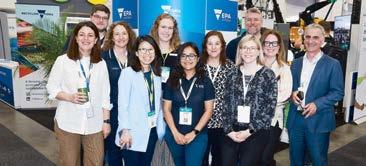
WesternAustralia’snaturalbeautyisunder-appreciated.
WA’s natural beauty
Thechallengeistoprotectthis,whileupgradingthe economic and social infrastructure to underpin regional development.
The issue came into focus when a Cockatoo member and his wife left Canberra in Februarywith a 24 foot caravan - for the grand tour of Western Australia. Every couple of days he sent back photos of their exploits across the Nullabor, then Kalgoorlie (wonderful buildings), Coolgardie (virtual ghost town), Esperance, (stunning beaches), Cape Le Grand Coastal Trail (white beaches, blue water), Porongurup National Park (great caravan park), Stirling Ranges (more stunning scenery) Albany (126mm rain in one day), Karri Forest (aweinspiring) and Margaret River (wine tasting, Busselton Jetty).
Next they were ‘spending another mind blowing’ day in Kalbarri National Park and Port Gregory which he said was a bit like Mad Max because everyone gets around on quad bikes and dune buggies. But they didn’t stay in Kalbarri itself because everything was booked. Obviously Sandgropers have concluded - like yours truly – that Kalbarri is one of the most beautiful places on the continent.
Then onto Coral Bay (turtles, fish, coral) where they stayed three nights, but wished it had been 33 - followed by snorkeling on Ningaloo Reef. Then a stationstaynearthePilbara,followedbyPortHeadland to reflect on the scale of iron ore exports, the salt mine in the middle of town and piles of scrap metal 100 metres high. Onward to the delights of Broome. The foregoing travelogue is a backdrop to opportunities.
1. Untapped tourism potential
WA’s extraordinary natural beauty is hardly recognised by Australians, let alone overseas folk.
Indeed, our Cockatoo friend is not easily impressed or given to hyperbole. But he says ’in WA most things are way more impressive than expected. So, one takes particular notice.
The fascinating question is whether WA can

leverage this natural beauty to capture a bigger slice of future tourism business. In this regard, WA’s tourism pitch ‘Walking on a Dream’ makes eminent sense. It implores people to ‘step outside of the everyday and into a dream. A place where reality and the otherworldly combine.’
The Walking on a Dream theme should appeal to young Europeans and Asians looking to break the shackles of their humdrum life. Indeed a working holiday in WA should become a rite of passage for youths. It would provide them with an eternal momento of a different, happy lifestyle Downunder, once they retreat to their cramped apartments in Manchester, Paris, Mumbai or wherever.
There are supporting factors for this scenario - Perth is 4 hours closer to Europe than our east coast - Perth’s residents have strong ties to the UK (37 per cent have UK ancestry) - Qantas now has non-stop flights from Perth to both Paris and Rome
- Perth is relatively close to India.
2. Royalties to Regions
The second opportunity is for WA’s tourism sector to continue to benefit from the very interesting Royalties to Regions Program. It involves the setting aside of 25 per cent of the royalties received by the WA Government from mining and petroleum producers.
The program, championed by the Nationals, was enshrined in WA legislation around 2009. It
now disburses around $1,200 million annually for all sorts of regional projects viz. boat harbours, caravan parks, affordable housing, indigenous health.
It’s a wonderful program because it fast tracks regional projects, doesn’t require federal involvement, clearly demonstrates the results of taxes paid by mining companies (rather than going into Consolidated Revenue) and it will underpin the long-term development of the state’s regional tourism sector as above. Interestingly, the WA Department of Treasury & Finance is a constant critic.
The regional economies of Queensland and South Australia could similarly benefit from a similar program, given their significant mining exports. But it’s hard yards, given the entrenched attitudes against the devolution of government spending. I have a hunch that Hendy Cowan, the WA Nationals leader, was the dogged champion back in the 1990s. Fifteen years later, an Act of Parliament was the result. It’s worth reading up on Hendy.
Crookwell’s gem
Lindner Socks makes knitted woollen socks in Crookwell, 45km west of Goulburn NSW. It’s a quality product, based on the comparative advantage of local merino wool, and the entrepreneurial talent of the owner Andrew Lindner. Its website (Lindnersocks.com.au) is very good, and an important part of the sales function.
Lindner Socks is a great example of regional development, and the company’s success could provide a platform for the co-location of other businesses with a focus on value-adding local product. In this regard, Crookwell is famous for its potatoes, but potato chip manufacture seems to have passed it by.
The district is steeped in history, and one of its early denizens was Dame Mary Gilmour, the poetwriter-activist who appears on the $10 note. Worth a visit.
Melbourne-Daylesford lifestyle trail
IwasinWoodendlastmonth.It’spartofalinealcluster of lifestyle communities with numerous funky small businesses and significant tourist traffic viz. Macedon, Romsey, Woodend, Lancefield, Kyneton, Daylesford. How this cluster has developed could be the basis of a PhD thesis, but until then we’ll settle for the fact that these towns are within a day trip radius of Melbourne as well as stop-off points en route to Ballarat and Bendigo. Conversely, west Gippsland, on the other side of Melbourne, hasn’t captured the opportunity. There is an untapped tourism trail from Melbourne’s eastern suburbs to Powelltown, Noojee, Neerim, Neerim South, Warragul and then Drouin. The farms are emerald green formostoftheyear,theforestsaremagnificent,and there’s gourmet food and a potentially vibrant pub and restaurant offering.
Investment Attraction
There’s a lot of talk in Canberra these days about our need to forge new trade and investment links with Europe, Asia, South and Central America. About twenty years ago, the feds were seriously into this. Invest Australia was part of the Industry Department and was headquartered in Sydney, with offices around the world. Its role was to provide data, regional and industry profiles, strategic background and connections to potential overseas investors. It had 120 staff, which was massive overkill, and it surely raised the ire of then Finance Minister Lindsay Tanner, because he vowed to close it down. This he did, and Austrade took over the function with a handful of staff. This has now been reduced to zero!
Quote of the Month
“Australia needs America for its defence, but Australia only needs defence because of America.”former PM Malcolm Fraser (2014) Rod Brown is a Canberra-based lobbyist specialising in industry/regional development. Email apdcockatoo@iprimus.com.au
TheCityofBoroondarahastakenouttheVictorianLGPROaward’sprestigiousInnovativeLeadershipAwardforits InnovationAcademy.
Held in Melbourne earlier this month, the award recognised the hard work, creativity, and commitment to excellence from Boroondara Council officers.
The Council also received a high commendationforitsBookableSpacesInitiativeintheDigital and Technology category.
According to Boroondara City CEO Phi Storer both projects reflect the council’s unwavering commitment to improving services for the community through innovation and excellence.
Hosted by LGPro, the peak body representing professionals in the Victorian local government sector, the Awards for Excellence celebrate outstanding achievement and innovation across councils in the state. The LGPro Awards for Excellence are Victoria’s premier local government awards.
Storer congratulated staff on the well-deserved recognition following the award.
“Every day I see innovative and inspiring work being done by Council officers to improve the lives of residents, and these winning programs are just two examples of this brilliant work.”
“This recognition at these prestigious awards demonstrates our commitment to delivering excellent services to residents, powered by new technology and a customer-centric approach. We are not perfect, but we are focused on delivering better outcomes for our community,” Mr Storer said.
Now in its sixth iteration, the Boroondara Innovation Academy is a 12-week training program that empowers staff to develop innovative, real-world solutions to Council challenges. With a focus on experimentation, autonomy, and executive support, the academy is driving a culture of innovation within Council operations and service delivery.
Participants learn a structured innovation pro-
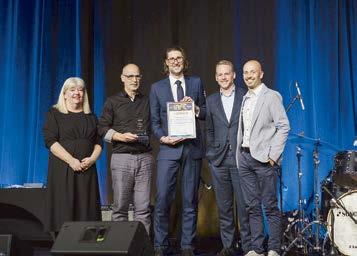
cess while working across departments, producing outcomes that lead to measurable improvements and new ways of working across Council.
TheBookableSpaceInitiativehastransformed the way residents interact with Council’s bookable spaces. By consolidating 89 bookable facilities into one streamlined digital platform, the initiative significantly improved user experience and access to information.
Since launching:
· The new ‘Book a space’ web page has been accessed over 45,000 times by more than 31,000
users
· More than 5,800 bookings have been made through the new booking system
· Calls to customer service for basic booking information have dropped by 65%
· Staff time spent on booking administration has reduced by over 60 per cent
This initiative has not only improved convenience for the community but has also delivered operational efficiencies and received positive feedback from both users and staff.
The recipients were awarded live as part of
LGPro’s Annual Conference on Thursday 5 June. The Awards promote and celebrate the outstanding work being undertaken and delivered by individuals and teams across the sector. This year’s awards included 15 categories to cater for the broad range of services and professions representing local government.
The 15 award categories, and their winners, include:
· First Nations Community Partnership - Central Goldfields Shire Council.
· Community Assets and Infrastructure Initiative (projects under $5m): Mount Alexander Shire Council.
· Community Assets and Infrastructure Initiative (projects $5m-$20m with a population of under 50,000): Hepburn Shire Council.
· Community Assets and Infrastructure Initiative (projects $5m-$20m with a population of over 50,000): Mitchel Shire Council.
· Community Assets and Infrastructure Initiative (over $20m): Glen Eira Shire Council.
· Community Partnerships: Ballarat City Council.
· Digital and Technology: Gannawarra Shire Council.
· Disaster Readiness and Recovery: East Gippsland Shire Council.
· Diversity and Inclusion: Mildura Rural City Council.
· Environmental Sustainability: Yarra Ranges Council.
· Innovative Leadership (previously Innovative Management): Boroonda City Council.
· Service Delivery: Banyule City Council.
· Special Projects: Greater Shepparton City Council.
· OutstandingSmallRuralCouncilInitiative:Hepburn Shire Council.
· Young Achiever: Samantha Johns.







Arecord1300Mayors,ShirePresidentsandCouncillorsfromacrossAustraliaattendedthe31stNationalGeneral AssemblyinCanberraduringJune.
The annual event featured a wide range of guest speakers and panellists discussed local government issues across four days, including financial sustainability, geopolitics, technology, disruption, innovation, drought resilience, emergency management, rural mental health, affordable housing and safer roads.
The NGA also included a Ministerial Engagement Forum was held on Friday 27 June, featuring a range of Federal Ministers and Shadow Ministers.
A highlight was the launch of ALGA’s groundbreaking new climate adaptation research on 26 June.
The Adapting Together: Local Government Leadership in a Changing Climate report showed councils are expected to spend more than $2 billion over the next five years to support their communities from the changing climate.
All photos courtesy of the Australian Local Government Association.




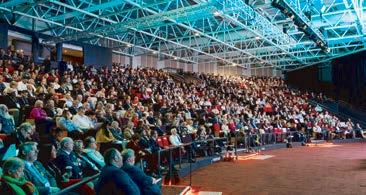
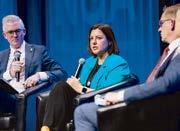

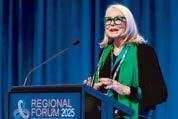

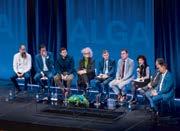



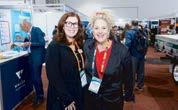

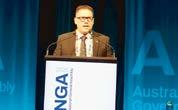



ShapeTomorrow’sWorldatthe2025InternationalPublicWorksConferenceAustralasia’slargestpublicworksand infrastructureeventisheadingtoSydneythisAugust,withthe2025InternationalPublicWorksConference(IPWC)set tobringtogetherhundredsofpublicworksprofessionals,civilengineers,andassetmanagersfromacrosstheregion.
Held at the International Convention Centre from 25 to 28 August, this year’s IPWC will explore the theme “Shaping Tomorrow’s World.”
Hosted by IPWEA, the peak membership association for public works and asset management professionals across Australia and New Zealand, the event will address some of the most pressing challenges facing the sector today, including the issues of ageing infrastructure, climate resilience, managing community expectations, and rapid technological change.
The preliminary program has been curated and is now live. Take a look at the program highlights below.
A Conference Designed for Today’s Challenges
With more than 80 practitioner-led sessions from local government engineers, asset managers, practitioners, and consultants, IPWC 2025 is designed to equip professionals with the tools and knowledge to drive change in their organisations.
The agenda includes:


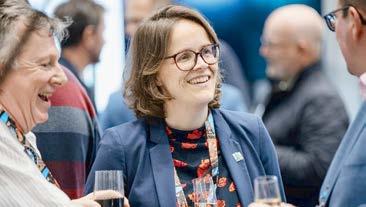
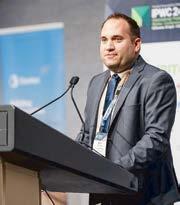
Excellence Awards Gala Dinner on Thursday 28 August.
· Four Focused Streams: Public Works in Action, Technology, Asset Management, and sustainability.
· Inspiring NextGen Sessions: Presented by early-career professionals showcasing their projects.
· One-day Street Lighting and Smart Controls Forum: Running on Tuesday 26 August as part of IPWC with presentations from Australia’s leading lighting experts.
· Exciting Networking Opportunities: Connect with peers and suppliers both in and out of the Exhibition Hall including at the Casual Dinner at Squires Landing, and the IPWEA




· Technical Tours: Running on Friday 29 August, the Technical Tours are add-ons open to conference delegates and provide the opportunity to visit either the new satellite city of Bradfield, the new Hunter Street Metro Station, or the UTS Technical Labs.
Valuable Speakers
This year’s keynote lineup includes: NSW Premier, Chris Minns, who will open the Conference. Thought leaders such as Maria Atkinson (NSW Net Zero Commission), The Hon. Matthew John Kean (former Minister for Energy), Lt Col Andrew Hansell (19 th Chief Engineer
Works), Geoff Cooper (NZ Infrastructure Commission), Ursula Bryan (Institute of Asset Management UK), and Adam Copp (Infrastructure Australia), Professor Arnold Dix, international tunnelling expert and engineer, on collaboration and leadership in complex environments. Kate Munari, former Navy helicopter pilot, on building strong, high-performing teams. Why Attend?
According to IPWEA CEO David Jenkins, IPWC 2025 is more than a conference, it’s a crucial opportunity to stay ahead of sector shifts and make informed, future-focused decisions.
“We’re giving practitioners the tools, insights, and connections they need to deliver long-term, sustainable infrastructure solutions,” Jenkins
says. “There’s never been a more important time to come together and share ideas.”






Whether you’re looking to deepen your expertise, connect with peers, or bring fresh ideas back to your team, IPWC is a must-attend event for anyone involved in then planning, delivery, or maintenance of public infrastructure.
Don’ Miss Out! Register soon to secure your place Don’t miss your chance to be part of Australasia’s largest public works and infrastructure event. Register soon to join hundreds of peers, thought leaders, and innovators as we shape the future of public works together.
Visit www.ipwc.com.au to learn more and register today.













Townsville City Council has endorsed the Event Specific Local Recovery and Resilience Action Plan (ESLRRAP)a comprehensive plan developed by the Local Recovery andResilienceGroupcapturingrecoveryactionsalready underway while setting the direction for the next stages ofrecoveryfollowingthedevastatingNorthandFarNorth Tropical Monsoon Low event that began on 29 January thisyear.
The extreme weather system delivered recordbreaking rainfall from Cairns to Mackay and west to Etheridge Shire.
In Townsville, 16 consecutive days of rain produced an average of 1.2m worth of rainfall across the city - nearly a full year’s rainfall in just over a month. The result was widespread flooding, landslides, significant infrastructure damage and the evacuation of about 4000 residents.
Despite the scale of the event, recovery efforts began immediately.
Local Recovery and Resilience Group Chairperson and Councillor Ann-Maree Greaney said the plan formalised and strengthened the extensive recovery work that had been progressing during the past six months.
“Recovery in Townsville didn’t wait for a plan to be published, it started the moment the rain stopped. This document brings together the many actions already taken and sets out a clear roadmap for the continued recovery of our people, infrastructure, economy and environment,” Cr Greaney said.
The ESLRRAP outlines how recovery agencies across Townsville have been supporting displaced residents, restoring damaged infrastructure, coordinating health and wellbeing services, and reconnecting communities. It also details upcoming priorities and longer-term resilience initiatives.
“This plan acknowledges what’s already been
achieved through strong local leadership and community effort, and it ensures we stay focused and coordinated for the work still to come,” Cr Greaney said.
“Early funding support from the State Government, along with the rapid establishment of the InsuranceHubatQueenslandCountryBankStadium and the Small Business Recovery Hub at Smart Precinct NQ, ensured vital recovery assistance was delivered to affected residents and businesses in the critical early weeks.”
Major infrastructure routes such as the Bruce Highway, Flinders Highway, Gregory Development Road and Ollera Creek Bridge were impacted by the event, along with local roads, rail lines and air services.
The flood also increased public health risks and placed significant stress on homes, businesses and community wellbeing.
“The ESLRRAP reflects the reality that recovery is a marathon, not a sprint,” Cr Greaney said.
“We’re committed to supporting our community through each stage and building a stronger, more resilient future for Townsville.”
Australian Institute of Marine Science (AIMS) CEO Professor Selina Stead thanked Council for its prompt response in restoring access to Cape Cleveland Road. For more information on how Townsville recovers following a disaster, visit Council’s Recovery Information page.

TheroadrunningtothesmallvillageofTyalguminthe Tweed Shire has been fully restored, allowing double laneaccesstoTyalgumvillageforthefirsttimesince the2022floods.
In February 2022, the biggest recorded floods in the Tweed’s history caused major devastation to Tyalgum Road, , known affectionately by locals as ‘The Crack’, resulting in a landslip more than 100m wide and 60m deep.
This meant the main arterial road between Tyalgum and Murwillumbah was unpassable, forcing residents and visitors to take a longer alternative route via Chillingham.
Tweed Shire Council, working with Transport for NSW, engaged contractor SEE Civil to restore the road and in March 2023 work started on ‘The Crack’. Now, more than 2 years later, the $24 million project is complete.
Tweed Mayor Chris Cherry said that Tyalgum Road has been one of the major roadworks for Council since the 2022 floods and she was delighted it was finished.
“Thanks to all the staff at Tweed Shire Council and SEE Civil who worked on this complicated project,” Cr Cherry said.
“Their teamwork and dedication have delivered an outcome which will benefit not only the village of Tyalgum, but the Tweed community for many years to come.
“I would also like to sincerely thank the Tyalgum community for their patience and understanding. We know that it’s been difficult at times but we hope that this safer road will be worth the wait,” Cr Cherry said.
Funded by the Australian and NSW Governments through the Disaster Recovery Funding Arrangements, the size and scope of the work presented challenges for engineers and designers. They were also thwarted by weather conditions, which were anything but favourable at times.
The project was completed in several phases.
One of the key priorities when work began was to stabilise the extreme slip site. This, in itself, was no easy task. It required the use of some very heavy machinery - with a 70 tonne crane working in tandem with a huge piling machine which would eventually see the installation of 130 concrete piles driven 15 metres into the earth.
Once this was done, a temporary access route was established in October 2023 for Tyalgum residents and businesses which reduced the need to take the long way around to Murwillumbah via Chillingham.
However, this track was subject to the weather, forcing the installation of automatic
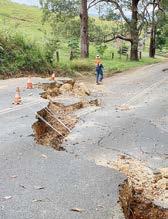
Thebadlydamagedroad.
gates which would close if rainfall exceeded the amount determined by engineering experts.
As the road was completed, an additional 130 pile tieback anchors were bored into the bank and 3300 tonnes of rock were brought in to fill 197 gabion baskets that were locked together to ensure the restored road will endure for years to come.
There was also a strong Tweed presence on the project – 90 per cent of the SEE Civil employees were residents of the Tweed Shire including supervisors, engineers, project managers and machine operators.
Federal Minister for Emergency Management Kristy McBain said Tyalgumn had faced a long road to recovery since the 2022 floods, and reconnecting the community marks a major milestone for locals who’ve been doing it tough,” Minister McBain said.
“Disaster recovery isn’t just about rebuilding roads, it’s about restoring the vital lifelines that connect people to each other and to services.
“Since day one, we’ve been working alongside communities like Tyalgum to not just recover but to rebuild stronger and be better prepared for future disasters.
“This is what disaster recovery funding is all about. Real outcomes that make a real difference in people’s lives, especially in regional communities.”
Lismore City Council’s mission to rebuild, restore and strengthencommunityassetsandinfrastructurefollowing the devastating 2022 natural disasters has reached a significantmilestone,with100projectsnowcomplete.

Delivered by Council’s Flood Restoration Portfolio (FRP), the projects span roads, bridges and landslips; sporting venues, cultural hubs and community facilities; and vital flood resilience infrastructure, including urban stormwater drainage.
Combined, they represent approximately 30 per cent of projects in the FRP’s schedule of works, Lismore City Mayor Steve Krieg said.
“Our driving goal has been to deliver the best outcome for the Lismore community – to do it once and do it right,” he said.
“The Flood Restoration Portfolio team has been doing great work since the disaster, and following extensive emergency repairs, funding applications, and designing innovative solutions to our unique challenges, it’s now shifting into an exciting new construction phase.”
Among the notable achievements so far are:
· Restoration of 55 road, bridge and landslip damages, including works on Nimbin Road
and Blue Knob Road.
· Restoration of Lismore City Library, Lismore Regional Gallery and Quad, Lismore Municipal Building and Lismore Airport Terminal.
· Restoration of Albert Park Baseball Complex, Lismore Basketball Stadium, Lismore Workers FC Clubhouse and Marie Mackney Netball Clubhouse.
· Clearing of more than 8kms of urban stormwater drains.
More than 230 additional projects are now in the advanced planning, design and construction stages, with road restorations and flood resilience upgrades to see the highest focus in the coming months and years.
The Flood Restoration Portfolio is proudly funded by the Australian and NSW Governments.
Find out more at www.lismore.nsw.gov.au/ Building-and-planning/Flood-RestorationPortfolio.
IncommunitiesacrossAustralia,localgovernmentsitsatthefrontlineofengagement.
Shaping Smarter Engagement: Why Local Government Needs to Invest in Capability Building Now
Whetherit’slong-termplanning,infrastructure projects, climate action or social policy—councils are the connection point between decision-makers and the communities they serve. And that connection is only becoming more complex. The expectations are clear: people want to be heard, and they expect their input to influence real outcomes. But delivering authentic, wellplanned engagement requires more than goodwill—it requires skills, systems and a strong culture of participation.
That’s where the Engagement Institute comes in.
Formerly known as IAP2 Australasia, the Engagement Institute has evolved into a new era of training, resources and thought leadership. At its core is a commitment to empowering practitioners and organisations to lead engagement that delivers better outcomes for communities—and greater confidence for councils.
Capability that’s grounded in practice
The Engagement Institute’s training framework isn’t just theoretical—it’s grounded in practical tools and real-world scenarios. The starting point is the Essentials of Engagement, a course that introduces the principles, ethics and frameworks that underpin best practice. From there, participants can build towards the IAP2 Australasia Certificate of Engagement, by completing key modules like Design & Plan Engagement and Apply Engagement Methods.
There’s also an Advanced Certificate, offering deeper dives into topics like strategy development and managing outrage—areas particularly relevant in high-stakes council engagement.
Local governments aren’t expected to become engagement experts overnight. But investing in foundational training creates a shared

language, consistent standards and, importantly, more effective conversations with community.
Tailored for local needs
While public courses are available across the country and online, many councils are turning to in-house delivery—a flexible option for teams of 10 or more. This format means the training can be tailored to your context, using local case studies and challenges to bring the learning to life.
Building confidence and connection
The sector is seeing a shift. Engagement is no longer an add-on—it’s central to good
governance, smart policy and trust in public institutions. But with that comes pressure. Staff often say they feel unsure, overwhelmed or underprepared. Training can help break that cycle.
Feedback from past participants reflects this clearly. Many describe the training as “transformative,” not just for the tools and models, but for the confidence it instils. It helps practitioners feel more equipped, more supported and more able to navigate complexity with clarity.
Investing in what matters
For councils, the return on investing in engagement capability is tangible. It leads to more


considered planning, fewer project delays, and stronger community relationships. It helps avoid the pitfalls of reactive consultation and enables more proactive, inclusive decision-making.
Training won’t solve every challenge—but it’s a powerful step toward more deliberate, valuesdriven practice.
As the sector continues to evolve, one thing is clear: when councils invest in their people, communities reap the benefits.
To learn more about the Engagement Institute’s training options visit engagementinstitute. org.au.


StudentsfromAlescoSeniorCollegeareleadingalarge-scaleecosystemrestoration projectasoneof18localclimateactioninitiativestoreceiveashareoffundingfromCity ofNewcastle.
The project, designed and facilitated by ReGen Alliance, will see students plant 750 native trees on their campus in Elemore Vale, turning degraded bushland into a living classroom.
The funding has been delivered through City of Newcastle’s Youth Climate Action Grants thanks to a $150,000 contribution from Bloomberg Philanthropies Youth Climate Action Fund.
City of Newcastle Executive Manager Environment and Sustainability Marnie Kikken said the response from young people and community organisations has been inspiring.
“These projects reflect the energy and innovation of young Novocastrians committed to creating a safe and climate-resilient future,” Ms Kikken said.
“With this latest round of funding, we’re not just supporting environmental outcomes, we’re supporting education, equity and empowerment, all aligned with the goals of the Newcastle Environment Strategy.”
Deputy Chairperson of City of Newcastle’s Liveable Cities Strategic Advisory Committee Cr Elizabeth Adamczyk said this funding gives our young residents the chance to design and deliver urgent climate solutions.
“These projects show that when we support youth with the practical tools and resources to address their climate change concerns, they’re empowered to make a visible, lasting impact in their own communities and shape a healthy and sustainable future for our city,” Cr Adamczyk said.
ReGen Alliance’s Living Classroom project is putting this into action, with Alesco Senior College students participating in weekly learning sessions, to lead all stages of the project from site preparation, to planting and monitoring.
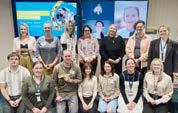
Co-founder of ReGen Alliance, Rebecca Giddins, said the program offers a chance for students to grow confidence and connection through nature-based learning.
“This program creates a safe, positive space where students can connect with nature and develop a sense of purpose. This project will offer a long-term educational opportunity to observe how ecosystems grow and adapt over time,” Miss Giddins said.
City of Newcastle is one of only three Australian local governments selected to participate in Bloomberg Philanthropies’ global initiative and has now distributed $225,000 across 30 projects over two rounds of funding.
Microgrants between $1,500 - $7,500 were available to young people aged 15 to 24, or organisations who represent them, to design and deliver local climate action projects.
Among the young grant recipients are University of Newcastle students Luca Surman and Ryan Muir, whose Bingage initiative began as a university project and evolved into a smart recycling initiative.
Mr Muir said the project incentivises young people to participate in recycling by gamifying the process for students living on Callaghan Campus.
“By linking everyday actions to social recognition, data insights, and reward-based challenges we’re aiming to build lasting habits and a culture of sustainability among students,” Mr Muir said.
“Participants engage through smart bins and an integrated app that rewards positive recycling behaviours, like rinsing bottles or returning sponsor-branded waste, with points.
“Once the return target is met, the student or team with the highest contribution wins a major prize, and the collected waste is upcycled into infrastructure projects through local businesses and installed on campus.”
Other successful projects include Lambton High School’s Eco Bloom project, which will see students create a pond and garden habitat for local wildlife through native planting and water conservation techniques, and Hunter Innovation and Science Hub, which will deliver an electric vehicle festival for youth and hands-on solar energy education for primary school students.
Newcastle High School’s Conservation Critters program will see students deliver guided nature tours and pollinator picnics to educate people of all ages about biodiversity, the value of native species, and how to take environmental action in their own backyard.
Projects funded in round two of the Youth Climate Action Grants align with City of Newcastle’s Climate Action Plan, supporting clean technology, circular economy initiatives, green and blue space restoration, electric transport, and the development of zero-emissions industries.
SwanHillstudentsareinJapanvisitingtheregion’ssistercity,Yamagata,aspartof theYamagataStudentExchangeProgram.
Following the enriching visit from Yamagata students in March, it’s now time for 15 of the local students to make the return journey and stay with host families in Yamagata.
Deputy Mayor, Councillor Les McPhee said the students, accompanied by four group leaders, flew into Tokyo before boarding a bullet train to Yamagata, where they will be welcomed by their host families and spend 10 nights immersed in local culture.
“During their stay, students will enjoy a rich cultural itinerary, including experiences such as yukata dressing and a traditional tea ceremony at Seifuso, a safflower workshop, and two days attending a local school,” Cr McPhee said.

“They will also visit the historic Yamadera Hojusan Risshakuji Temple, go cherry picking, explore Mt Zao, and take part in Zen meditation at Shoinji Temple.
“Additionally, students will have the unique opportunity to wear samurai armour and learn about its history at the Mogami Yoshiaki Museum”
The group will then return to Tokyo for an overnight stay, with plans to spend a day at Disneyland, visit the historic Sensoji Temple, and the Tokyo Skytree before flying home.
Cr McPhee said the exchange was a valuable and unforgettable experience for young people in the region.
“We’re fortunate to have such a strong bond with Yamagata – these experiences broaden minds and build lasting connections,” he said.

TheShireofMurrayhas excelledinitsfinancial reportingobligations, beingannounced amongthetop20local governmentsforbest practicebytheOfficeof theAuditorGeneralfor WesternAustralia.
Measuring local governments for their timeliness and quality of financial reporting and controls, the Auditor General reported an analysis of 135 local governments and highlighted the Shire of Murray among the list of high achievers.
Shire of Murray President, Cr Douglas McLarty, said the results demonstrate the Shire’s genuine commitment to good governance.
“At the Shire, our strong governance framework continuously drives us towards excellence,” said Cr McLarty.
“Being awarded among the top twenty best practice councils by the Auditor General, recognises our genuine and ongoing efforts to be accountable to our community. It is a testament to the professionalism of our staff and their integrity,” he added.
The recognition came as part of the Auditor Generals’ Financial Audit Results 2023-24, which was tabled in Parliament in April.
It is already the second time the Shire has been recognised among the top councils since the OAG began recognising the top-twenty for best practice just three years ago.

ItiswithgreatsadnessthatCityofNewcastleacknowledgesthepassingofformerLordMayorJeffMcCloyfollowing hisbattlewithmotorneuronedisease.
Mr McCloy will be remembered as a prominent business leader and icon of the Hunter’s development and construction industries, whose life’s work made a significant contribution to the city’s growth and infrastructure.
The well-known businessman served as Newcastle Lord Mayor from 2012 to 2014, campaigning for the removal of the heavy rail line through the city centre and Newcastle’s urban renewal. He was recognised as an outspoken advocate for bringing development and prosperity to the city.
Newcastle Lord Mayor Ross Kerridge paid tribute to Mr McCloy’s contributions to the city.
“Jeff McCloy was one of the region’s most successful business people of recent years. His drive, his can-do attitude and his passion for the community were all hallmarks of his success,”
Cr Kerridge said.
“A particular achievement was his leadership and resolve that enabled his team to finish construction of the new John Hunter Hospital well ahead of schedule after the 1989 earthquake. This was crucial to Newcastle‘s recovery and reconstruction.
“His enthusiasm for his hometown was demonstrated by his widespread involvement in many community matters, including, notably, being the Lord Mayor. Less well-known is that he was a significant donor to various local charities and to public art and sculpture. He also quietly and discreetly helped out many Novocastrians in personal difficulties.
“Like all big achievers he had his critics, but no one can deny his passion and positive commitment to the community.”
City of Newcastle CEO Jeremy Bath said Mr McCloy had left an indelible mark on Newcastle.
“Jeff McCloy served for two years as the Lord Mayor of Newcastle but his true legacy is as a property developer for more than fifty years,” Mr Bath said.
“Jeff saw the potential in Newcastle when many others didn’t. We today almost take for granted that developers want to build and invest in Newcastle. This wasn’t always the case.
“Jeff’s belief in Newcastle dating back to the 1980s convinced others that ours was a town that had the potential to become a city.”
Mr McCloy grew up in Belmont and gained a degree in Civil Engineering from Newcastle University. In the late 1970s he joined the Belmont-based construction company founded by his father, Don, before taking over the reins in
the mid-80s.
As the Chairman of the McCloy Group, he oversaw significant residential, commercial, and retirement living projects across Newcastle and the Hunter region, nominating the construction of the John Hunter Hospital as his proudest professional achievement.
Known for his philanthropy, Mr McCloy was dedicated to supporting charitable organisations, education and welfare groups, medical research, sports teams and clubs, while his passion for public art has enriched communities across the region and supported local artists. Mr McCloy was awarded the City of Newcastle Medal in 2009 for highly distinguished service to the city and community of Newcastle and outstanding contributions to the philanthropic support of charitable and community organisations.
SincethetragiceventsofOctober7,2023,Australiahaswitnessedanalarmingsurgeinantisemiticincidents.The CombatAntisemitismMovement’s(CAM)2025AustralianCitiesReportdocumentsover2,000suchincidentsinthe yearfollowingtheattack—astaggering316percentincreasecomparedtothepreviousyear.Theseacts,rangingfrom graffitiandverbalabusetophysicalassaultsandarson,havepredominantlyoccurredinurbancentreslikeSydneyand Melbourne,hometothemajorityofAustralia’sJewishpopulation.
BySachaRoytman,CEO, CombatAntisemitismMovement
This rise in antisemitism is not just a concern for the Jewish community; it strikes at the very core of Australia’s values of inclusivity, respect, and multicultural harmony. When synagogues are defaced, Jewish schools are targeted, and individuals are attacked for their faith, it undermines the safety and cohesion of our entire society.
Local governments are uniquely positioned to address this challenge. Councils are the closest tier of government to the community, making them vital in fostering safe and inclusive environments. They can implement educational programs, support interfaith initiatives, and ensure that hate crimes are promptly addressed and condemned.
networks, and develop practical strategies to protect civic unity and social cohesion.
The Combat Antisemitism Movement is a global coalition engaging more than 900 partner organisations and millions of individuals from diverse backgrounds in the common mission of fighting antisemitism. We believe that by
working collaboratively, we can build a future free of bigotry for Jews and all humanity.
Local councils have the opportunity to lead by example. By taking proactive steps to combat antisemitism, they not only protect their Jewish residents but also reinforce the values of diversity and inclusion that define Australian society.
We encourage all local government leaders to participate in the upcoming summit and to take decisive action in their communities.
For more information on the Australian Mayors Summit Against Antisemitism and to register your interest, please visit: https://mayors. combatantisemitism.org/goldcoast
Join local government leaders from across the country for a landmark summit dedicated to combating antisemitism and strengthening democratic values in Australian communities.
In September 2025, the Gold Coast will host the Australian Mayors Summit Against Antisemitism—the first national summit of its kind dedicated to local government leadership in confronting antisemitism. Building on successful CAM-led initiatives around the world, this event will bring together hundreds of Australian mayors and councillors to share insights, strengthen
LEADERSHIP. COMMITMENT. ACTION.
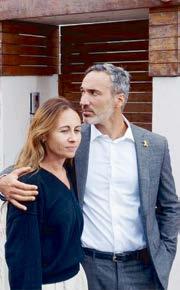




Join local government leaders from across the country for a landmark summit dedicated to combating antisemitism and strengthening democratic values in Australian communities.
This national convening will bring together mayors, deputy mayors, and councillors from every corner of Australia to engage in high-level dialogue, share best
are on the rise in Australia and as community leaders we must commit to a safe and peaceful future. Your voice is crucial in showing that hate has no place in our society.
Acts of hate are on the rise in Australia and as community leaders we must commit to a safe and peaceful future. Your voice is crucial in showing that hate has no place in our society.
CHAIRED BY MAYOR TOM TATE
MAYOROFTHECITYOFGOLDCOAST
More than 250 local government leaders, and community advocates from across Australia will join together in a collective effort to secure and nurture common understanding and
This national convening will bring together mayors, deputy mayors, and councillors from every corner of Australia to engage in high-level dialogue, share best practices, and forge a united front against rising hate.
More than 200 local government leaders, and community advocates from across Australia will join together in a collective effort to secure and nurture common understanding and safety in our communities.
Wearecallingonlocalgovernmentleadersto standup,speakout,andtakeaction.
Admission is free of charge. All travel and accommodation costs will be covered by the hosting organizations.
Admission is free of charge. All travel and accommodation costs will
3-5 SEPTEMBER, 2025 GOLD COAST, QUEENSLAND FORADDITIONALINFORMATION,PLEASEVISIT




Building on the year’s biggest tourism news — the announcement of a Lenny Kravitz concertinNovember—Milduraisridingawaveofvisitorinterest,withtourismspending surginginanumberofkeyareasoverthepast12months,injecting$220millionintothe localeconomy.
Events and Tourism Councillor Rebecca Crossling said Council’s latest tourism data showed increases in spending across almost every key category including:
· 18 per cent increase in spending on attractions, events and recreation compared to 8.5 per cent for regional Victoria
· 17 per cent increase in spending on breweries and wineries, compared a drop of 8.1 per cent for regional Victoria
· 14 per cent increase in spending on local restaurants.
“We’ve seen this momentum building in the 10 months since the Tropical North Victoria (TNV) campaign was launched in August 2024,” Cr Crossing said.
“We saw the staggering amount of national media coverage when TVN was launched, providing us with around $2.5 million in advertising value, which certainly got us out there in the minds of potential visitors.”
Council’s Manager Economic Development and Tourism Leesa Merrett said the region was now beginning to see the impacts of this exposure.
“It was always going to take a little time for this to translate into visitor numbers – you don’t launch a tourism campaign like this and expect visitors to immediately flock to our region in the first couple of months,” Mrs Merrett said.
“We know that people generally plan their holidays months in advance based on work and family commitments, which is why we’ve seen the increased visitor numbers and spending gradually building over the past 10 months.
“We’re now seeing clear evidence of this. If we look at Easter 2025 as an example, spending compared to the previous year was up in almost every category, injecting $14 million into local businesses over five days, a 10%
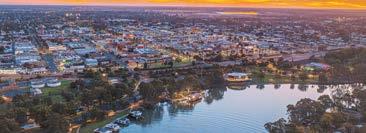
increase in visitor spending compared to the previous year.”
Mrs Merrett said interest was continuing to ramp up based on the latest Wotif data which showed Mildura is the top trending domestic destination in Australia for July – a 257 per cent increase in searches for the July school holidays. The next closest destination was Carlton which was up 77 per cent.
“While it’s no coincidence this comes on the back of our TNV campaign, I think there are a couple of other factors at play as well – a similar combination of factors that saw our record day visitor numbers in 2022,” she said.
“If we look back to 2022 where we saw a spike in visitor numbers, we had the Kings of Leon concert, an AFLW game and a WNBL game within about four weeks. We’d also come out of COVID and the impacts of the Murray River flood event.
“This year, we’ve already had the launch of Trail of Lights, which will ramp up further during the warmer months of the year and just this week it was announced Lenny Kravitz will perform here in November, which is massive in
terms of drawing visitors to our region.
“And behind all of that is the ongoing momentum of the TNV campaign, which has reached millions of people across the country, showcasing the breadth of options our region has to offer a whole raft of demographics and interests.”
Local tourism operator Maureen Croft from Tranquil Waters Caravan Park said despite early misgivings the new campaign had brought tourists their way.
“Initially when I heard about the Tropical North Victoria campaign I was very sceptical, it seemed a bit ridiculous to me and a lot of Mildura people felt the same way,” she said.
“But as far as our business goes it’s been a resounding success, we have Tranquil Waters Caravan Park at Lake Cullulleraine and we had the busiest summer holidays and pre Easter/ Easter holidays ever. We have had the park for six years.
“Whether people think it was good publicity or bad publicity it got Mildura and surrounds noticed and I guess that’s what the campaign was all about.”
TownofWalkervilleis finalisingits12-month FoodOrganicsGarden Organics(FOGO) educationcampaign.
The council is investigating the possibility of moving towards a FOGO bin system, which would mean green waste would be picked up weekly and the landfill and recycling would be picked up fortnightly.
Town of Walkerville has been directly targeting residents in the Township, aiming to improve our landfill diversion targets by getting food and green waste out of our blue bins and into green bins.
With assistance from Bin Thinking, Council managed to run a Townshipwide door-knocking campaign, meeting face to face with local residents to discuss their bin habits and provide them the opportunity to sign up for a free green bin, kitchen caddy or bin liners.
Additionally, Bin Thinking ran education presentations at local schools in the area and held a pop-up waste education stall.
Residents and school students learnt about waste, FOGO and landfill diversion, and were able to easily access green waste bins and kitchen caddies.
Council will be considering all the feedback and outcomes of this campaign to determine Council’s position on a FOGO bin system.
TheremotecommunitiesofCentralDarlingShireinfarwestNSWwillheadtothepollson20Septembertoelect councilrepresentativesforthefirsttimeinmorethanadecade.
Minister for Local Government Ron Hoenig and Member for Barwon Roy Butler will today meet with Central Darling Shire Council in Wilcannia to provide an update on the next steps as the Council prepares to exit administration.
To support Central Darling Shire Council’s transition back to elected representation and to set the Shire up for a more sustainable future, the Minns Labor Government has also committed $6 million in the upcoming 2025-26 State Budget.
Mr Hoenig said the $6 million in funding, to be delivered over two years, would assist the Council in achieving long-term financial stability. The funding will support capacity building and the delivery of essential local government services and infrastructure projects critical to the Shire’s future.
“For far too long, the task of bringing Central Darling Shire Council out of administration was put in the too hard basket.
“With an election date now set, we are another step closer to returning elected repre-
sentation for the communities of the Shire.
“The $6 million funding support will help set Central Darling up for long-term success and give assurance to communities that the Council can provide the services and infrastructure they deserve.
“Reaching this milestone wouldn’t have been possible without the tireless advocacy of the Member for Barwon. Roy has fought for many years to achieve this result and has worked with the government every step of the way to reach this outcome for his communities.”
This significant step marks the next chapter for the residents of Central Darling Shire and establishes the state’s first Rural and Remote Council, made possible by legislation passed last year.
Under this new governance model, Central Darling Shire Council will comprise of six councillors. Three will be elected by the community each representing one of the established council wards, and three councillors will
be appointed by the Minister for Local Government.
The hybrid structure is designed to ensure strong local representation while maintaining stable governance through the inclusion of appointed members with relevant skills and expertise.
The NSW Government’s Rural and Remote Council model addresses the unique challenges faced by councils in geographically isolated and sparsely populated regions.
Central Darling Shire is the largest council by land size but has one of the smallest populations, with less than 2,000 residents. The council has been under administration since 2013 due to long-standing financial and governance issues, and it is currently the only local government area in NSW without an elected council.
The Government previously provided more than $475,000 to Central Darling Shire to help fund its upcoming election and support councillors in their new roles. The Council held can-
didate and community information sessions in late 2024, and additional sessions are planned in the coming months to support community participation in the election.
Member for Barwon Roy Butler welcomed the announcement that he has been lobbying for over many years.
“It’s a first positive step back towards democratic representation, but it marks a significant change for Central Darling after more than a decade in administration,” he said.
“I’d like to thank the Minister Ron Hoenig for hearing the desire of the communities in the Central Darling Shire to return to some form democratic representation and for changing legislation to allow this start back towards elected representatives.
“This model has the capacity to change to allow more elected representatives in the future. Its success will depend on the community getting behind it and getting involved.”
TheCityofGreaterBendigohasappointedAngelaHaysasitsnewDirectorCorporatePerformance.
Ms Hays joins the City following roles as Head of People and Customer at Melton City Council and Director Corporate Services at Mackay Regional Council.
Chief Executive Officer Andrew Cooney said Ms Hays’ experience in providing high level strategic direction, financial management, and her sound understanding of Local government processes made her a strong candidate.
“Angela has built a diverse career in government roles, while leading and supporting capable teams across a diverse set of portfolios,” Mr Cooney said.
“Angela will be leading the Financial Strategy, IT, People and Culture, Governance & Performance and Customer Engagement & Communication units.
“Having recently relocated to Bendigo with
her family; Angela is excited about contributing to the community she now calls home. We look forward to Angela joining the team and bringing her leadership, skills, and experience to the organisation.”
Ms Hays said she was excited by the opportunity to contribute to the continued success of the City.
“Having previously worked in Local Govern-
ment, I understand the important leadership role a council has in a community,” she said.
“The City is a highly regarded Local Government and I am delighted to accept this role and get to know the Corporate Performance staff and broader organisation.”
Ms Hays will started with the City on Monday, 7 July 2025.
Fifty-oneyearsandeightmonths.
That’s how many years Ray Mahoney has worked for Burnie City Council.
After a lifetime of commitment to the Burnie community, Ray has decided to retire, effective 27 June 2025.
Beginning with Council on 8 October 1973, Ray’s first position would see him working nights, on foot following the garbage truck, slinging bags of rubbish in the back. In 1973 a new car would cost $3,200, and petrol was 67c a litre.
Ray has continued in the waste team for the majority of his time at Council, with a short stint
in Civil construction.
The council estimates Ray has picked up 10 million bins, travelled 750,000kms, and used 1.5M litres of diesel in his time here at Council.
Burnie City Council General Manager Shane Crawford said “To serve the community for over half a century is an extraordinary achievement”.
“Ray’s unwavering dedication, reliability, and hard work have made a significant and lasting impact not only within his team but across the entire organisation,” he said.
“As Mayor, and as a mum who raised four little people here in Burnie, I have fond memories
of Ray waving to my kids as he passed by on the rubbish run often with four of them all lined up at the fence waiting to see him,” Mayor Teeny Brumby added.
“I know our family isn’t alone. So many children across Burnie have grown up with the familiar and friendly wave from Ray. Thank you, Ray, for the way you’ve not only served our city but connected with our community so warmly over so many years”.

NoosaNorthShorejustgotQueensland’sfirstContainersforChangebagdropinanationalpark,withevery10 centsgoingstraighttosupportingCooloolaCoastCare.
ByAbbeyCannan
This pod is one of the new additions to improve waste and recycling in the Cooloola and Inskip Peninsula recreation areas, and it’s based at the Noosa North Shore transfer station.
Cooloola principal ranger Danielle Mansfield said, “Cooloola is proud to have this as a first at our park.“
“We hope everyone gets behind it and carries out what they carry in.“
Express Recycling Noosa site manager Dion Lawrence said, “The litter over here is quite an issue and I’m really hoping that this pod is going to go a long way to help that issue.“
For groups like Cooloola Coast Care, the benefits of reducing waste stretch beyond just a cleaner park, it’s about protecting wildlife.
Cooloola Coast Care president Lindy Orwin said, “For turtles, eating plastic ends up in death.“
“Wehavehalfamillioncamperscomethrough here in a year. It’s a lot of people and they’re all here for a good time, so we hope they share their good time leftovers with us, and that will help the turtles.“
Rainbow Beach based Turtle Care member Jan Waters said there were 44 successful turtle nests in the region during the 2024-2025 season.
“It was a good year because there’s a bit more food out there for them, as the sea grass has grown back after being affected by floods.“
“During the turtle hatching season, from November to April, we ask campers to keep their lights off and not to drive on the beach during high tide.
“The statistics over the last 20 years say only one in 1000 sea turtle hatchlings make it to adulthood. So, if we can work to save even one nest, then why not?“
COEX chief executive officer Natalie Roach praised the project as a benchmark for others.
“As a first in Queensland, this really is a standout for Containers for Change,“ she said.
“It really sets the opportunity for other national parks to get on board to get even more containers recycled across the state.
“I’d also like to congratulate the the Express RecyclingGroupastheyhavejustreachedamilestone of over 500 million refunds through their container refund points. That’s a huge achievement. It’s put $5 million in 10 cent refunds back into the community they serve.“
Noosa MP Sandy Bolton said, “Dion and Josie at Express Recycling Noosa continue to fight to make real change in this space in the community and we’re so deeply appreciative. “We all know that litter has been an issue and this is an enormous and positive step to capture that.“
From 30 June 2025, all waste bins along Teewah Beach and at the Freshwater camping area will be relocated to two new transfer stations at Noosa North Shore and on Rainbow Beach Road.
Ms Mansfield said, “Having less bins near the camping areas will ensure a cleaner, naturebased holiday, a reduction in smells and less rubbish dumped in the dunes.”
“Our protected areas are not just destinations. They are living, breathing areas that our community love.”
TheGlenelgShireCouncilhaswelcomedthelatestfundingboostforsouth-westfarmers,followingtheannouncement oftheVictorianStateGovernment’srenewed$75milliondrought-reliefpackage.
The Glenelg Shire Council has welcomed the latest funding boost for south-west farmers, following the announcement of the Victorian State Government’s renewed $75 million droughtrelief package.
The package includes funding for up to a 40 per cent reduction on council rates for eligible farmers, fee and duty relief and additional investment in mental health services and decision-making support.
The latest injection brings the total support for local drought-affected communities to $144 million since May.
Glenelg Shire Mayor Cr Karen Stephens praised the Victorian Government for its timely action. “This support package is a lifeline for
many of our farmers, who are enduring one of the driest seasons in recent history,” she said.
“The direct assistance will help address some of the immediate financial pressure and allow cash to be put back into the daily household budget or towards much needed stock feed.
“We welcome the opportunity to work directly with the Victorian Government to administer this assistance and look forward to receiving further details on when these payment reductions can be applied. As a council we are on the ground with our communities every day—we understand the hardship and we know how best to deliver the support where it’s needed most.”
While the funding is a positive step, Cr Ste-
phens stressed the importance of continued support for the agricultural sector.
“This investment is an important start, but the road to recovery will be a long one. Drought impacts don’t disappear with one funding round, they affect future production, mental wellbeing and local businesses well beyond a single season,” she said.
“Council will continue to advocate for additional resources and longer-term planning to ensure the future of our region’s farming communities are secure and sustainable.”
To view the full range of financial, technical and wellbeing support available to drought impacted farmers visit agriculture.vic.gov.au/ drought.
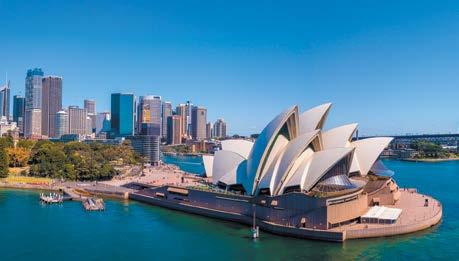

access a pump track, playground, barbecue facilities, public toilets and new car parking year-round.
Upgraded BMX facilities include a Union Cyclist Internationale (UCI) accredited track with a 5m start ramp for training and racing.
About 350 people attended a community open day at the facility on 28 June, with an official opening by City of Cockburn Mayor Logan Howlett who said Malabar Park offered something for everyone.
“Whether you are a BMX enthusiast or a family looking for a fun day out, these fantastic facilities are here for the benefit of all Cockburn residents,” Mayor Howlett said.
“Last year the track was still under development when it was visited by Australian 2024 Paris Olympic gold medallist Saya Sakakibara and French bronze medallist Romain Mahieu.
“They tried out the track and gave it the seal of approval, saying it was “perfect for all skill levels.
“The facility also has new floodlighting. The City is grateful for a $100,000 State Government grant through the Department of Local Government, Sport and Cultural Industries’ Community Sporting and Recreation Facilities Fund.
“Along with a $20,000 funding commitment from Cockburn BMX Club, the City provided the remainder of the funding and is very proud the facility can also provide a permanent base for local charity Friends of the Community.
“Named Community Volunteer Organisation of the Year at the City’s 2023 WA Volunteer of the Year Awards, this training and catering charity has been dedicated to reinvesting all pro-
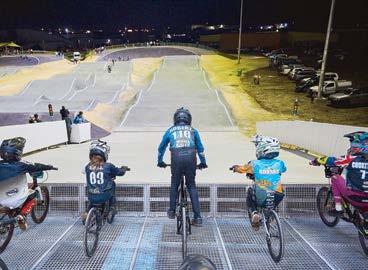
ceeds from food sales at events it attends, back into the local community since 2006.
“The UCI accreditation means the track can be used for larger competitions which will bring people from around Australia to Cockburn all year round.
“These welcome visitors will contribute to the local economy by spending on goods and services, with this significant investment also
yielding economic benefits for the City, its businesses, and residents.”
Cockburn BMX Club Chairman Kirk Taylor said the City of Cockburn had set a new standard for BMX facilities in WA by transforming Malabar Park into a recreational asset the whole community could enjoy.
“It will be a popular destination for BMX racing and training, community BMX riding, birth-
day parties and family gatherings,” Mr Taylor said.
“Saya Sakakibara’s 2024 Olympic gold medal and the highly anticipated opening of Malabar Park has thrust BMX racing into the spotlight as an alternative to mainstream sports.
“The increased community interest in BMX will help the club expand, as new participants experience what our members have enjoyed for over 30 years.
“Whether riders participate for fun and fitness or are on elite development pathways, the improvements to Malabar Park will now provide riders with modern, world class infrastructure, in which to train and compete.
“The facility will attract national BMX events and draw competitors from across Australia, potentially injecting millions of dollars into the local community.”
Friends of the Community Inc President and Co-founder Norm Dale said he was thrilled Malabar Park had become the charity’s new home.
“This partnership marks an exciting opportunity for growth and collaboration as we look towards the future,” Mr Dale said.
“The new facility will enable us to expand our youth training programs, incorporating new modules that emphasise technology and computer-based learning.
These initiatives will provide our volunteers with essential skills for their future careers.
“We are also excited to showcase our coffee van, equipped with a state-of-the-art coffee machine that will offer barista training for our youth.
“Our fully accredited food van will also serve a variety of delicious meals, including hot favourites like roast beef rolls and sausage sizzles.”


